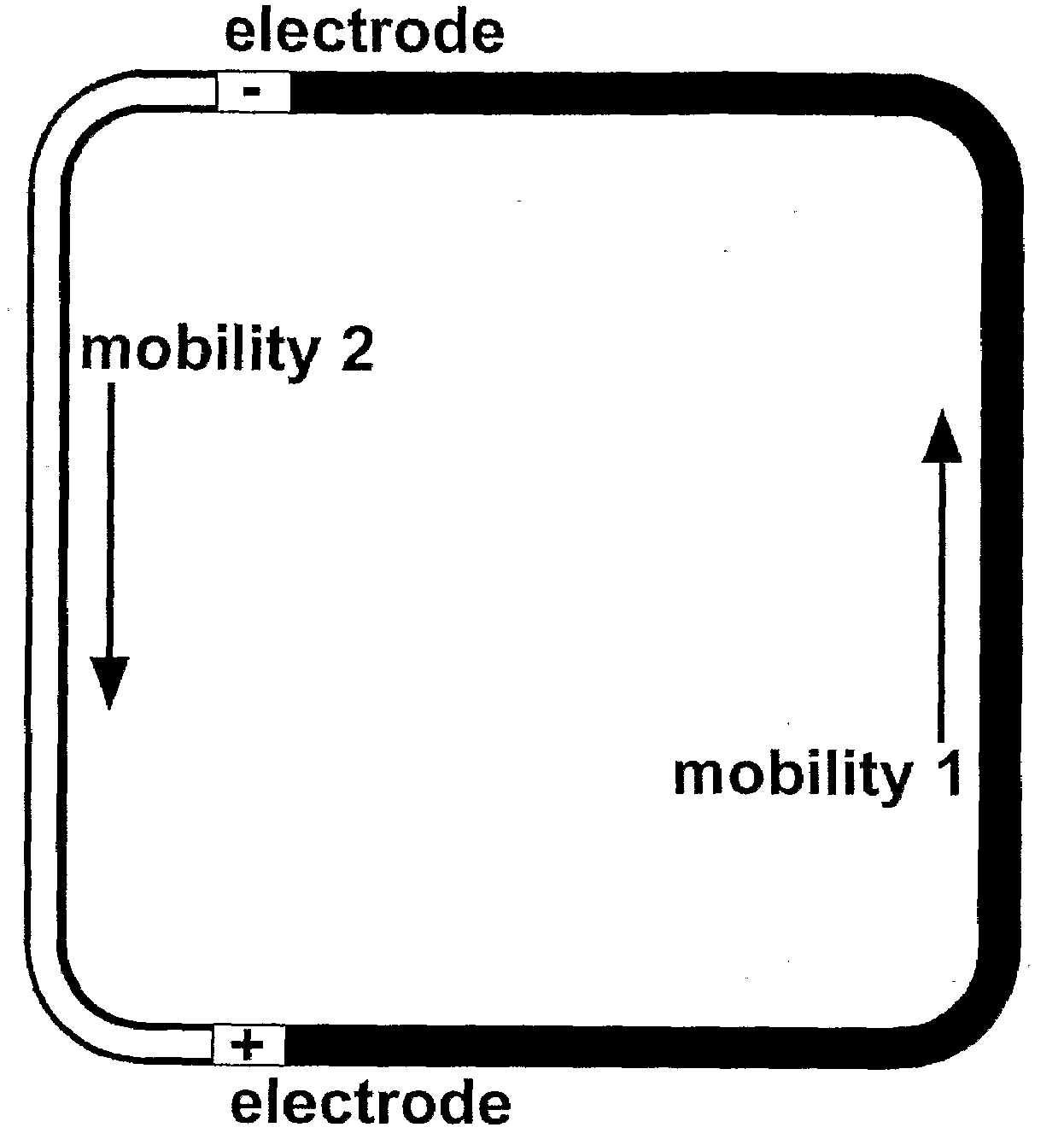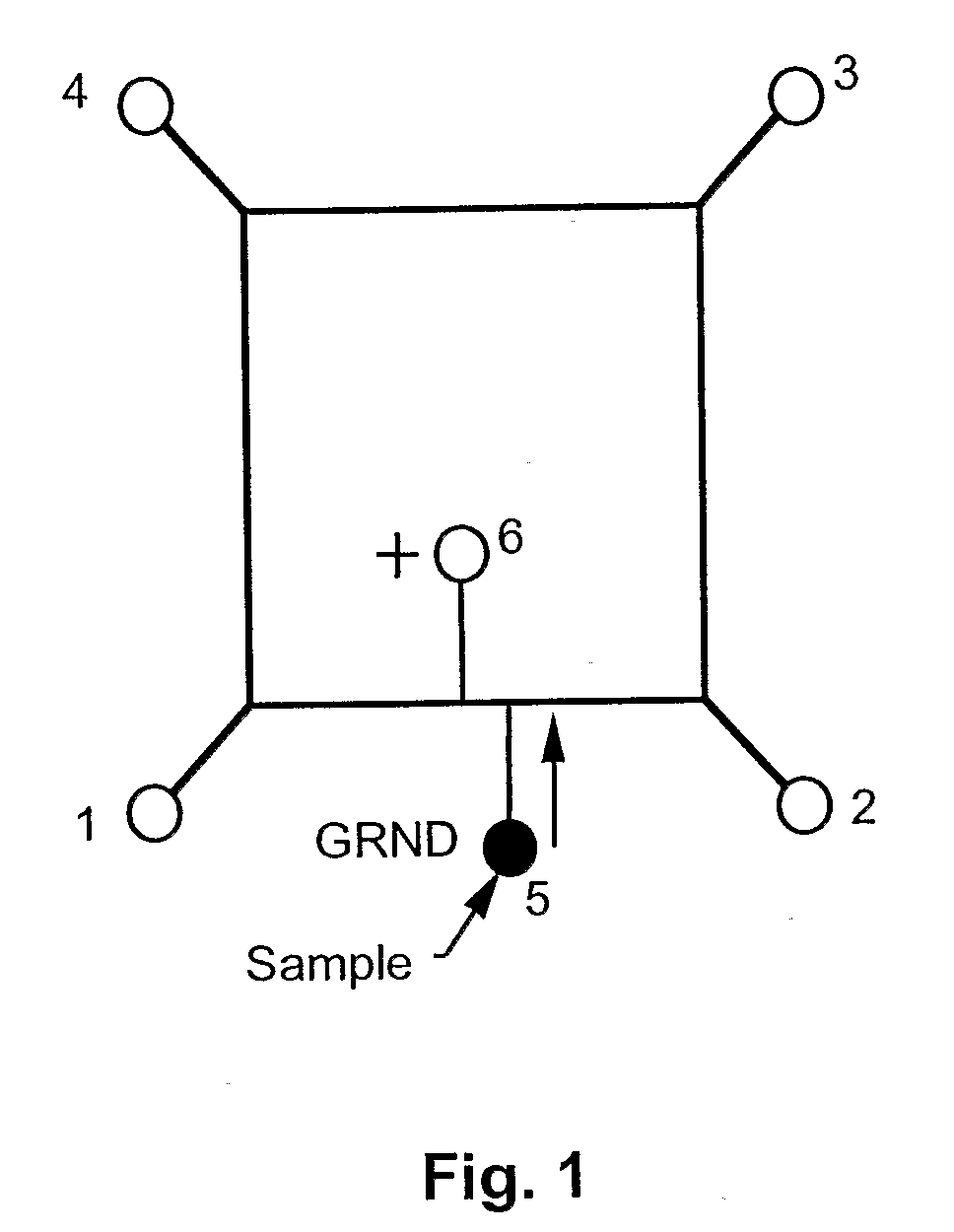Electrokinetic Thermal Cycler and Reactor
a technology of electric kinetic and thermal cycler, which is applied in the direction of analytical using chemical indicators, laboratory glassware, instruments, etc., can solve the problems of less uniformity, and achieve the effects of high accuracy, rapid operation, and low error ra
- Summary
- Abstract
- Description
- Claims
- Application Information
AI Technical Summary
Benefits of technology
Problems solved by technology
Method used
Image
Examples
example 1
[0049]Microchip Design and Fabrication. A prototype embodiment of the invention has been constructed. The channel size in the PCR reactor microchip prototype was 100 μm in width, 70 μm in depth, and 7.9 cm long, for a total reactor volume of 0.55 μL. Access channels positioned at each corner of the reactor had the same dimensions as those of the reactor channel.
[0050]This prototype embodiment, and the synchronized, cyclic, continuous-flow PCR process are depicted schematically in FIG. 1, and FIGS. 2A through 2D. FIG. 1 depicts sample injection. Reservoirs 1-4 accommodated electrodes for applying voltages between points 1 and 3, as well as between points 2 and 4, for moving the DNA plug through the three temperature zones in a synchronized fashion. A DNA sample was injected into reservoir 5, and a voltage was applied across the electrodes in reservoirs 5 and 6. Sample was moved across the reactor channel to fill the crossed T injector. FIGS. 2A through 2D depict sample cycling. The c...
example 2
[0052]Temperature Control: Each of three temperature zones was heated by a surface-mounted resistor array. Temperatures were monitored by four K-type thermocouples embedded within each array, close to the contact surface between the heater and the chip. Zone temperatures were maintained within 0.5° C. by a PID type control loop. To maintain as uniform a temperature as possible, and to reduce heat transfer between zones, each heater was isolated by an air gap from neighboring heaters. Because some heat transfer is inevitable, the resistance of the end resistor of any zone that is adjacent to a higher temperature zone may be increased to reduce some of its heat generation. By moving the sample through independent temperature zones, the time delay due to temperature ramping is greatly reduced. The delay, therefore, depends principally on the sample migration time from zone to zone, and heat transfer to or from each zone. The surface-mounted heaters were sealed onto a separate polycarbo...
examples 3 and 4
[0053]Surface Modification of PC Microchannels: Various surface modification techniques otherwise known in the art may be used; the surface modifications should be stable in the temperature range of interest, e.g., that used for typical PCR or LDR reactions.
[0054]One approach employed a dynamic coating to modify the microchannel walls to alter the magnitude and direction of electroosmotic flow (EOF). A principal goal is that the EOF should not oppose the electrophoresis of charged species, e.g., DNA. For example, EQF for unmodified polycarbonate (PC) is positive. It is desirable to reverse the direction of the EOF for DNA, because the direction of electrophoresis for DNA is negative. The voltage needed to move DNA through the channels is reduced, and dispersion of the DNA plug due to counter-propagating flows of buffer and DNA is also reduced.
[0055]Hexadimethrine bromide (Polybrene, PB) was used as a dynamic coating material. The channel was first rinsed with 0.1 M NaOH and deionize...
PUM
| Property | Measurement | Unit |
|---|---|---|
| temperatures | aaaaa | aaaaa |
| temperatures | aaaaa | aaaaa |
| temperatures | aaaaa | aaaaa |
Abstract
Description
Claims
Application Information
 Login to View More
Login to View More - R&D
- Intellectual Property
- Life Sciences
- Materials
- Tech Scout
- Unparalleled Data Quality
- Higher Quality Content
- 60% Fewer Hallucinations
Browse by: Latest US Patents, China's latest patents, Technical Efficacy Thesaurus, Application Domain, Technology Topic, Popular Technical Reports.
© 2025 PatSnap. All rights reserved.Legal|Privacy policy|Modern Slavery Act Transparency Statement|Sitemap|About US| Contact US: help@patsnap.com



